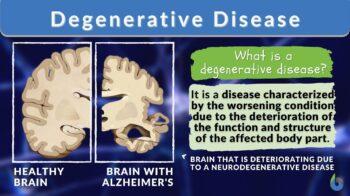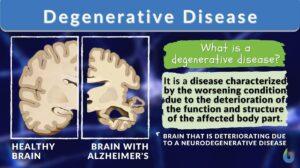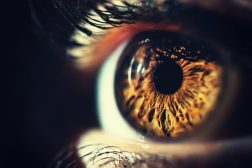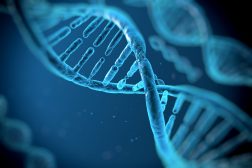
Degenerative Disease
n., plural: degenerative diseases
[dɪˈdʒɛn(ə)ɹətɪv dɪˈziːz]
Definition: a disease characterized by the worsening condition due to the deterioration of the function and structure of the affected body part
Table of Contents
Degenerative Disease Definition
A degenerative disease is defined as a disease characterized by the worsening condition due to the deterioration of the function and structure of the affected body part, thus causing disability, mortality, and morbidity, which could be premature.
Aging is a natural phase in life. At the organism level, the body tends to undergo and accumulate changes over time and these changes are usually degenerative. The body degenerates from its former prime condition, especially in terms of speed, efficiency, and repair. Inopportunely, there are also instances when certain individuals undergo degenerative changes prematurely.
Over time, these degenerative changes lead to symptoms and disease. Such a disease is referred to as a degenerative disease. Many of these diseases are associated with aging, genetics, and lifestyle choices. Also, many of these conditions are incurable and can only be managed to alleviate and improve symptoms.
Risk factors
What are the general risk factors for degenerative diseases?
Aging is one of the common risk factors for many degenerative diseases. It entails diverse biological changes.
- At the cellular level, a cell is aging when it loses its ability to divide and remain metabolically active.
- At the tissue and organ level, an aged biological structure is one that eventually wears off. Their structure and function are no longer as potent as they were when they were young.
This is often attributed to the genetic changes inside the cell, particularly the shortening of the telomeres. Deterioration over time can occur as a result of telomere degeneration. Consequently, the cell loses its ability to function upon reaching a certain point. When several cells lose their capacity to divide and function effectively, the body would, therefore, be impaired. The disease manifests as symptoms appear.
Apart from natural degenerative changes caused by DNA damage accumulation from aging, the body may also be susceptible when exposed to many stressors, e.g. oxidative stress.
Mitochondrial DNA mutations are also an important risk factor.
Read: Mitochondrial DNA – Hallmark of Psychological Stress
Examples of Degenerative Diseases
Below are examples of degenerative diseases:
Neurodegenerative Diseases

Neurons tend to deteriorate or degenerate over time. Neurodegeneration is the progressive loss of structure and function as well as the death of neurons. The condition may progress to neurodegenerative disease. Many of them are associated with aging, genetics, and lifestyle choices. Some have no cures but they can be managed to ease symptoms. Physical therapy may help in identifying the type of exercise program that can be applied to help minimize the difficulties or limitations caused by physical deterioration.
Examples of degenerative nerve diseases are Alzheimer’s disease, Parkinson’s disease, Huntington’s disease, Amyotrophic lateral sclerosis, multiple sclerosis, and Batten’s disease.
Alzheimer’s disease
Alzheimer’s disease is a progressive neurodegenerative disease caused by the degeneration of the neurons. Affected person with this disease may have several areas of the brain affected. As such, the brain may progressively lose its cognitive function, such as memory and language.
Parkinson’s disease
Parkinson’s disease is another progressive neurological disease involving the melanin-containing nerve cells in the brainstem. Bradykinesia (slow movements) is one of the major symptoms. Also, individuals with this disease exhibit symptoms such as shuffling gait, stooped posture, resting tremors, speech impediments, movement difficulties, and an eventual slowing of mental processes and dementia.
Huntington’s disease
Huntington’s disease is a disease characterized by mental and physical deterioration leading to death. The individual with this disease initially lacks coordination and then eventually loses a steady gait, coordinated movement, and mental abilities.
Amyotrophic lateral sclerosis
Amyotrophic lateral sclerosis (ALS) is a disease caused by the death of neurons that control the voluntary muscles. Initially, there is a weakening of the arms or legs. Eventually, the person with ALS will lose the ability to use hands and feet, speak, and swallow.
Multiple sclerosis
Multiple sclerosis is a neurodegenerative disease characterized by the gradual accumulation of focal plaques of demyelination, particularly in the periventricular areas of the brain.
Batten disease
Batten disease is a neurodegenerative disorder characterized by an excessive accumulation of lipofuscin in cells and tissues. The accumulation of lipofuscin is due to a pathological mutation in a gene (e.g. CLN3 gene, in a juvenile type of the disease). The disease starts at the age of five to eight years. Some of the symptoms include seizures, ataxia, vision impairment, and clumsiness.
Watch this vid about neurodegenerative diseases:
Cancers
Cancers are characterized by the malignant growth of cells (from uncontrolled cell division) that can be invasive (metastasis). There are over a hundred types of cancers in humans. Many of them are due to poor lifestyle habits, e.g. tobacco use, poor diet, and lack of physical activities. Other risk factors are exposure to ionizing radiation and environmental pollutants.
Infections caused by certain viruses (e.g. Epstein-Barr virus, HIV, hepatitis B virus, hepatitis C virus, human papillomavirus, and Helicobacter pylori) may also increase the risk of developing cancer. Cancers are a degenerative disease because cancer growth could affect the function of adjacent cells. In the lungs, for instance, a lump could take up space and consequently prevent lung cells to absorb sufficient oxygen. The presence of malignant cells in the lungs could also impair the immune response and thereby increase the risk of acquiring lung infections.
Coronary Artery Disease
Coronary artery disease is a condition characterized by the progressive narrowing or the eventual occlusion of the coronary artery. It is the underlying cause of a heart attack. Risk factors are hypertension, smoking, diabetes, lack of physical activity, poor diet, and excessive alcohol.
Macular Degeneration
Macular degeneration is a medical condition caused by macular damage. The affected individual may experience blurred vision in the center of the visual field. Over time, the vision worsens and may end up in blindness. Risk factors include genetic factors, poor diet, lack of physical activities, and smoking.
Osteoarthritis
Osteoarthritis is a non-inflammatory degenerative joint disease occurring chiefly in older persons. It is characterized by the degeneration of the articular cartilage, hypertrophy of bone at the margins, and changes in the synovial membrane. It is accompanied by pain and stiffness, particularly after prolonged activity. Antiinflammatory medications are administered to relieve pain.
Osteoporosis
Osteoporosis is a degenerative disease involving the bones. The condition is characterized by extremely porous bones. Thus, an individual with osteoporosis has an increased risk of fracture. It commonly affects elderly women. It causes a curved back due to the compression fractures of the backbones.
Duchenne muscular dystrophy
Duchenne muscular dystrophy (DMD) is a degenerative disease characterized by the progressive degeneration of muscles. This leads to muscle weakness. It may manifest in children of ages 2 or 3 who may have difficulty jumping, running, and walking. It is a genetic disorder that is associated with a genetic mutation in the X chromosome that codes for the protein dystrophin. Without sufficient functional dystrophin, which helps keep muscle cells intact, the muscles tend to be fragile and prone to damage. (Duchenne Muscular Dystrophy (DMD) – Diseases | Muscular Dystrophy Association, 2017)
“Neurodegeneration is a two-phase process, according to a study”
Researchers from Rice University proposed two distinct phases of degenerative diseases like Alzheimer’s, Parkinson’s, and muscle atrophy at the cellular level:
- Early phase, when the activity of cell signaling proteins may either increase or decrease but overall brings about oxidative stress
- Late phase, when oxidative stress sets in, the cell signaling proteins behave differently from the initial phase
The two-phase process, accordingly, drives neurodegeneration forward. This also means that patients may have to be treated differently depending on which stage of neurodegeneration is at.
Source: Michael Stern, James A. McNew. A transition to degeneration triggered by oxidative stress in degenerative disorders. Molecular Psychiatry, 2020; DOI: 10.1038/s41380-020-00943-9
Take the quiz!
References
- NCI Dictionary of Cancer Terms. (2019). Retrieved from National Cancer Institute website: https://www.cancer.gov/publications/dictionaries/cancer-terms/def/degenerative-disease
- What are degenerative diseases? Department of Health website. (2010). Retrieved December 17, 2019, from Doh.gov.ph website: https://www.doh.gov.ph/faqs/What-are-degenerative-diseases
- What Is Cancer? (2015, February 9). Retrieved from National Cancer Institute website: https://www.cancer.gov/about-cancer/understanding/what-is-cancer
- Duchenne Muscular Dystrophy (DMD) – Diseases | Muscular Dystrophy Association. (2017, November 17). Muscular Dystrophy Association. https://www.mda.org/disease/duchenne-muscular-dystrophy
© Biology Online. Content provided and moderated by Biology Online Editors








